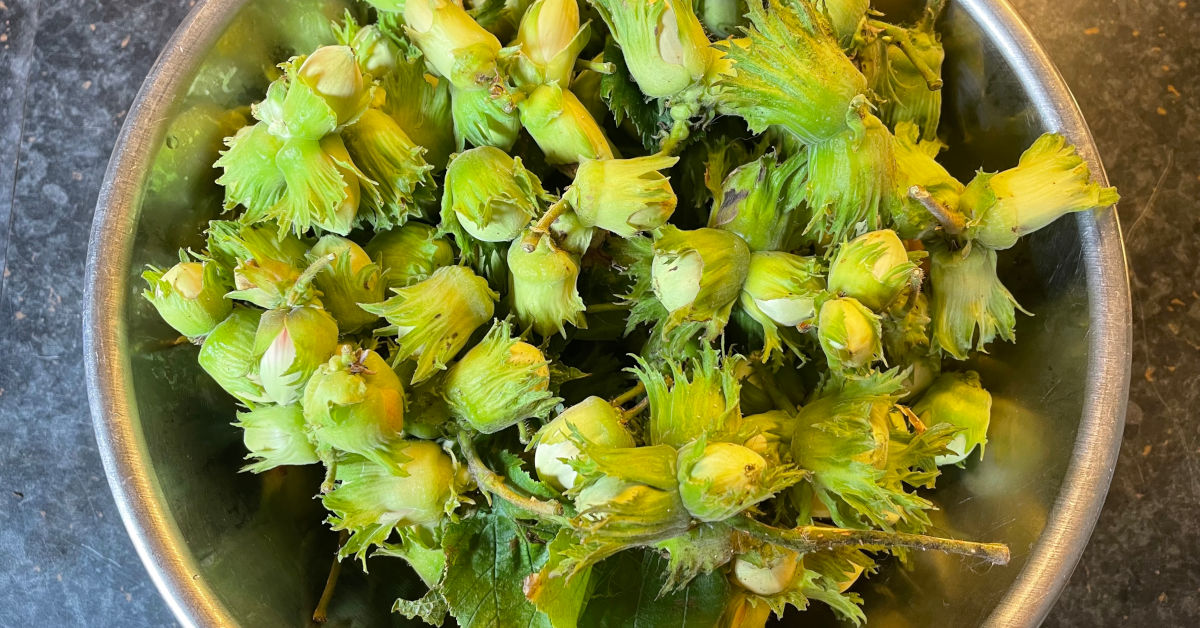I saw them last night during an evening walk with my husband. They were hanging there, showing off on a tree just outside the primary school not far from our house. I was lucky to have spotted them in the fading light. A cluster of four. I could feel my mood lighten. We stopped in our tracks, I picked the cluster of hazelnuts from the tree and I tested one with my teeth. BINGO! With a rush of simple joy, I cracked open the rest. Apart from one dud, they delivered too.
Welcome to the nutting season.
Some might argue that mid-August is too early to pick hazelnuts. I’d normally agree. My memories of running up the Welsh hills near my childhood home for our annual nut foraging bring with them the feelings of the end of summer and ‘back-to-school’.
However, despite the shells still being partially green, with only the base browning, these were perfect, and offering that delicate softness before the nut eventually turns hard when fully ripened. In an old article I found on the internet, Hugh Fearnley-Whittingstall describes this stage perfectly, singing the praises of the crisp crunchiness of the flesh and the sweet, vegetable like flavour that can, he says, be somewhat addictive. They are quite addictive indeed.
Having helped myself to a handful yesterday evening, I return to the tree today, working my way along the same hedgerow and following the path back to the main road on the other side of my house where there are plenty more trees. I regret not bringing a bowl or storage container or even the company of friends and family – not least because my youngest son is almost 6ft tall and has a much longer reach. It’s just that hunting high and low between the branches of suburban hazelnut trees on my own suddenly makes me feel uncomfortably odd, especially as I proceed to ‘hide’ my edible treasure out of sight in a cotton shopping bag that’s just slung over my shoulder.
I imagine the drivers passing by wondering or commenting out loud to others “What on earth is that woman up to?”. At least if I had a big bowl, it would give a visual hint. Maybe I should have worn a hi-vis vest. I would then appear as if I had some official standing, an official reason to be out staring at and inspecting the branches. After all, it was the council’s planners and housing developers who arranged the planting of this tree belt some twenty years ago and on occasion return to manage it.
Without a hi-vis or a bowl, I continue hunting my bounty, a solitary middle-aged woman with an air of eccentricity navigating my way along the tree belt, looking for nuts.
I resolve to bring my family next time, taking heart that even with my son’s extra reach, the trees are now so tall there will be plenty of nuts left for our local squirrel community. This reminds me that I haven’t seen our squirrel visitor in our garden for some time. It was once a regular, energetically bouncing across the pergola and up the trees, then along the fences, stopping and staring at me on occasion.

Earlier this summer I found a couple of rogue hazelnut saplings growing in a hanging basket and amongst my plants. An unintended gift from our now absent squirrel, I presume. Having now transplanted them, they will grow in homage to our fluffy tailed visitor and who knows, they may in time produce nuts of their own.
I return home both triumphant and relieved, emptying my foraged shopping into a large bowl.
Picking nuts in the middle of a modern Suffolk housing estate might not offer the same rural ambience as the historic hillsides of the Welsh valleys but my gratitude and sense of wonder are no less. There is something very grounding about sourcing food from the natural environment that is on our doorstep, using the knowledge of our ancestors passed down through the generations. For both our wellbeing and local nature, the trees are a real asset too, breaking up the sprawl of the built environment.
Next up will be blackberries. There is a great spot I know in a country lane, only a twenty-minute walk from home. For these, I will be sure to take a bowl.

For further advice about sustainable foraging, visit https://sustainablefoodtrust.org/articles/guidelines-for-sustainable-foraging/
Karen and The Team

Karen Cannard
Hi, I’m Karen, a Suffolk based writer who has a passion for turning the everyday into the extraordinary, especially on the subject of reducing waste.
As the creator of The Rubbish Diet in 2008, my curiosity about recycling, reuse and the life cycle of trash led to a series of waste-reduction campaigns, research into packaging design, reducing plastic, recycling electronics and exploring international zero-waste solutions.
I am a huge advocate of curiosity, which is also reflected by my ‘day job’ as a high school librarian and careers adviser. Curiosity is also how I’ve stumbled into becoming an allotmenteer. For now, the less written about that, the better.
I am delighted to join the Word Forest Organisation’s creative writing team. It’s a charity that I am very proud to support.





